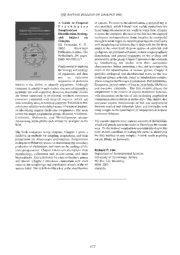
Book review: A Guide to Tropical Freshwater Zooplankton ñ Identification, Ecology and Impact on Fisheries. Ed. Fernando, C.H., 2002. Backhuys Publishers, Leiden, The Netherlands, 291 pages. ISBN 90-5782-117 PDF
Preview Book review: A Guide to Tropical Freshwater Zooplankton ñ Identification, Ecology and Impact on Fisheries. Ed. Fernando, C.H., 2002. Backhuys Publishers, Leiden, The Netherlands, 291 pages. ISBN 90-5782-117
THE RAFFLES BULLETIN OF ZOOLOGY 2002 A Guide to Tropical of species. To assist in the identification, a pictorial key is F r e s h w a t e r also provided, which I found very useful, particularly for Zooplankton – those being introduced to the world of water fleas. Chapter Identification, Ecology 4 covers the copepods. Because of the fact that the copepod and Impact on undergoes metamorphosis from naupliar to copepodid Fisheries through to adult stages, its identification requires familiarity Ed. Fernando, C. H., with morphological features; this is dealt with for the three 2002. Backhuys stages at the order level. Keys to species of calanoids and Publishers, Leiden, The cyclopoids are provided with notes on their zoogeographical Netherlands, 291 pages. distribution, and general comments on the ecology and ISBN 90-5782-117 productivity of the group. Chapter 5 introduces the ostracods by familarising the reader with their taxonomic Fundamental to studying characteristics before presenting a key and accompanying the biology and ecology notes to the identification of various genera. Chapter 6 of organisms, and their provides ecological and distributional notes on the less use as indicator dominant groups generally found in zooplankton samples. organisms in pollution These comprise the Protozoa, Coelenterate, Platyhelminthes, studies is the ability to identify organisms. Although Ectoprocta, several orders of Insecta, Arachnida, Mollusca, taxonomy is crucial to such studies, this area of research is and parasitic copepods. The last chapter places the generally not well supported. However, taxonomic studies zooplankton in the context of tropical freshwater fisheries, are better supported in developed, northern temperate with discussions on the role of fish in shaping zooplankton countries compared with tropical regions, which are composition and evolution in freshwaters. This chapter also represented by many developing countries. This book is thus compares trophic relationships of fish and zooplankton a welcome addition to the rather scarce information database between tropical and temperate lakes, and concludes with on identifying tropical freshwater zooplankton. The book some insights to the contribution of zooplankton to tropical covers the major zooplankton groups (Rotifera, Cladocera, freshwater fisheries. Copepoda, Ostracoda, and Miscellaneous groups representing seven phyla) each written by an expert in the The various chapters have copious amounts of illustrations, field. which will greatly assist the reader in identifying the various taxa. To the tropical zooplankton taxonomist/ecologist this The book comprises seven chapters. Chapter 1 gives a book should contribute to making life easier in identifying rundown on methods for sampling zooplankton, and their the little beasties in your samples. A book worth acquiring preparation for microscopic examination. Zooplankton for the library or personally. ecologists will find the section on determining the secondary production of cladocerans, and notes on the ecology of the main groups useful. Chapter 2 deals with the rotifers, their Richard P. Lim morphology, collection and preservation, and their Department of Environmental Sciences biogeography. This is followed by a key to families, genera University of Technology, Sydney and species. Chapter 3 introduces cladocerans with short PO Box 123. Broadway notes on the morphology and distribution of each of the 63 NSW 2007 species listed. This is followed by a key to the identification Australia 177
